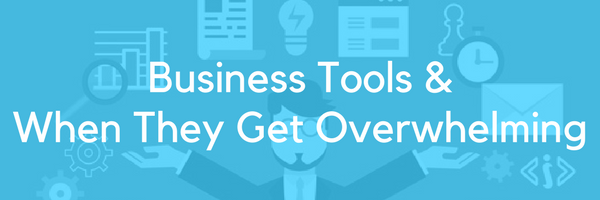What does your workday look like? Is it a whirlwind of acronyms, apps, CRMs, social media, PM tools and SAAS platforms?
The availability of business tools on the market right now can be overwhelming. Even when you’re not looking (talking to you, targeted Facebook ads) it’s easy to become bombarded with all the options designed to help your business.
Here are our 5 tips to beat the overwhelm when choosing business tools.
...Click the link below to read more
The availability of business tools on the market right now can be overwhelming. Even when you’re not looking (talking to you, targeted Facebook ads) it’s easy to become bombarded with all the options designed to help your business.
Here are our 5 tips to beat the overwhelm when choosing business tools.
...Click the link below to read more
1. Clarify what you’re looking for
“I need a Customer Relationship Management (CRM) tool.” is a broad statement. What’s important to you in a CRM? How much does it need to integrate with other tools? How much file storage is needed? Where is it hosted? How secure is it? Etc...
You can see how this might quickly snowball into indecision. When you’re not sure what questions to ask or where your answers fall, try a quick Google search to get you started. A quick article, preferably from a source that doesn’t sell the product you’re looking for, will help you understand how to narrow your search for the right tool.
2. Compare
I Googled ‘CRM Comparison’ and the first result was this website, whose whole gig is giving you all the info you need to purchase business solutions. There are tons of these kind of software review sites and they often have live chat options that will do most of the heavy lifting for you.
This particular site gives me 158 CRM options to start with, reviews, pricing and rankings including their own personal grid scoring system. Yikes, that’s a lot of information.
With two clicks I narrowed it down to 10 options (filtered by 5 star rating and price) and from there can easily click ‘Compare’ on the ones that look interesting to me or use the live chat function to get an expert opinion to narrow it down more.
So, that was less than five minutes of work and I have a good starting place for choosing a new CRM and an easy to read comparison matrix (especially great if you’re working with other departments or managers to make the decision). Comparison is essential and will help you understand the functions offered and what will work best for your company, don’t skip this!
3. Test it out with a trial
Most business tools will give you a free trial for some period of time. Even if they don’t offer one on their website, it never hurts to ask. They’ll likely give you a free demo or trial just for asking. A free trial is obviously the best way to see if the product fits your needs. Remember to make sure you know which functions you actually need and what level of the product you’re looking for as free trials will almost always give you all the premium functions that you may not have access to in a free or lower cost version.
4. Make a plan for how to use the tool
You found the one, now you just have to use it regularly (especially if you’re coughing up a monthly premium for it)! Is it something you need to use daily? Weekly? Monthly? Whatever the answer, one of the easiest ways to do this is to put it on your calendar. A weekly (or however often) reminder to check your dashboards and plan your next steps is a great way to make sure you’re getting the most out of your tools.
5. Don’t keep using it if it’s not working
The reason your tools are overwhelming might be because you have too many. The alternative to a fancy business tool doesn’t have to be a spreadsheet black hole. Try narrowing your focus again and see if there is a lighter version or alternative tool that still includes the functions you need without all the extras. Or if you really do need no frills, simple spreadsheets can still be a viable option.


 RSS Feed
RSS Feed